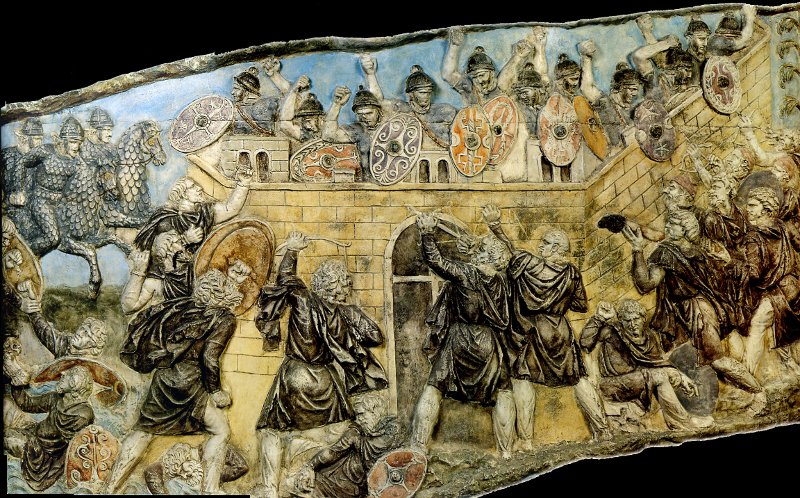Colors (polychrome) of Trajan's Column: scene XXXII (Dacians attack the Romans, refugees in a city);
In Roman Antiquity the architectural monuments as well as the sculptures (reliefs and statues) were represented in painting, i.e., they were colored with bright colors. This mode of visual perception in the Roman society was a "legacy" possible coming from the Greek art that used the same way to color their architectural and artistic monuments. Today, in the Western world, such a vision of architecture and sculptural art is not accepted any more, of course, as during the Egyptian, Greek, Roman etc. civilizations, and in the western religious middle ages.
Italian archaeologist and art historian Ranuccio Bianchi Bandinelli (1900-1975) proposed in a TV show in 19721, by the aid of a painter, to directly reconstruct on plaster mold (natural size) the scene XXXII - The Dacians attack the Romans refugees in a citadel, the likely original colors of Trajan's Column.

The X-ray fluorescence method showed that the whole Trajan's Column was painted. This was previously assumed, but no one knew exactly which the colors of the "paintings" in stone of the Columns were. The X fluorescence spectrometry ability to determine the presence, even infinitesimal, of the elements with atomic weight corresponding to a scale of values, after which the colored substances of the marble skin can be recognized, resulting in the photographic reconstitution of the "scenes" Column in their original appearance, i.e. colored. The iomage, the scene XXXII - Dacian assault against a Roman fortress, was exposed at the XLIIth Biennial of the Academy of Art in Venice, in 19862, in a thematic exhibition etitled Arte e Scienza (art and science), it being one of the elements of great interest of this exhibition3.
Importance of Trajan's Column for Romania - cultural projects to reproduce and raise this monument in Bucharest:
As seen in the lines above, Trajan's Column in terms of artistic interested in not only the West, but also the Romanian society.
The idea of the origin of the projects to have a complete copy of the precious monument for Romania dates back to the 19th century.
For this, we could say that a "step" was made by the famous Badea Cartan (Gheorghe Cartan, 1848-1911), a Dacian "descended from the Column", a patriot, lover of books and history, and fighting for the unity of the Romanian people. The strong love for his nation makes him leave in 1896 on foot from his home village Cârţişoara (Sibiu), in a the "documentary" journey to Rome, to see with his eyes the Dacians on theTrajan's Column, traveling for 45 days, breaking the five pairs of shoes. The legend says and the written testimony confirms that Badea Cartan, after spreading on the steps of the Column the Romanian wheat and ground brought by him, tired as he was, he fell asleep with his head on his bags and at dawn the guards confused the traveler with a Dacian soldier descended off the monument of Emperor Trajan, so striking was the likeness.
This deeply impressed the Italians, who have headlined in all the newspapers of the time, on the first page: "A Dacian dropped from Column: with the hair, the shirt and the cap, with pants and sandals." His photography was published and he was interviewed. He was introduced to the Romanian Ambassador in Rome, to Italian personalities and tied close friendship with the mayor of Rome. Badea Cartan caused a sensation in Rome, was invited in the political, cultural, journalistic media in Italy, he being received with sympathy and friendship4.
We could say that the first proposal for reconstruction of Trajan's Column in Bucharest belongs to Mihail Kogălniceanu. In 1867 in the press of that time propaganda is made to obtain funds to achieve a copy of "that immortal document of our history," as reported by the newspaper " Românul " of February 9, 1867. In the second half of the 19th century, painter Nicolae Popescu (1835-1877) of Banat advocates from Rome, in his correspondence with Iosif Vulcan, for a copy of the Column, "it being interesting and useful for our nation ... it would show every Romanian his origin, who were our glorious ancestors". He undertook the copy of the reliefs on Trajan's Column to be lithographed and spread among the people. Also, Alexandru Odobescu, in 1874-1875, at the Faculty of Letters of the University of Bucharest, in his archeology courses he said: "after the moulds made by the order of the emperor (Napoleon III) we could obtain, with minor sacrifices, a reproduction in bronze of the whole Trajan's Column, which would raise with pride, right in front of this building (University) ... ". These desires of the Romanian intellectual class were becoming increasingly serious and about to be accoplished, in 1887 a project was done by architects Schmieden, Weltzien and Speer v. to raise a monumental buildings in neo-classical style, which was to house the National Museum, the National Library and Academy, and it was to be placed on the quay of Dambovita, and in front of the building it was planned the reconstituted Column to be raised. V.A. Urechia proposes on November 12, 1882 in the Deputies’ Assembly a bill according to which in Bucharest an exact reproduction of Trajan's Column will be located. The copy followed to be made of galvanic copper in the plant in Oudry in Auteuil (France), against the sum of 678,000 lei. The marble and bronze base was designed to include data on important events in Romanian history (unification, independence), but the project has not come to be realized. In 1912, Al. Tzigara-Samurcaş arrange with the conservative of the museum of Saint-Germain-en-Laye (France), archaeologist Salomon Reinach, that, in exchange for copies of the metopes of Adamclisi, to obtain cast of the Column. Although arrangements were made, the project did not materialize. In the years 1934-1939 a decisive merit had archaeologist Emil Panaitescu, then the director of the Romanian School in Rome, who made a series of memoranda addressed to the Academy, Ministry of Public Instruction, Ministry of Finance, Parliament, winning in 1939 the Romanian state to order a copy of Trajan's Column to some craftsmen from the Vatican, led by Francesco Mercatalli. In the beginning only the spindle of the column was commissioned, and then the base. The cast works were made in time of war, the spindle of the column was completed in 1940 and the base in 1943. The Copy of the Column costed the Romanian state 4 million lei, which was paid in full. Making the casts was supervised by Emil Panaitescu, and their quality was checked by a committee represented by Guido Galli, technical director of pontifical museums, Italo Gismondi, arhelog and architect, Giuseppe Lugli, archaeologist, Virgil Vătăşianu, art historian, and Emil Panaitescun, archaeologist.
Because of the war the casts have not come to Romania immediately after their execution. Meanwhile they were housed in the basement of the Lateran Museum, the Forum of Trajan and in deposits of the Exhibition Palace. Finally the Column casts come to Bucharest in June, 1967. The Column reproduction is of a high quality: the material that was used, reinforced white cement mixed with marble dust, closer in appearance to the original, and the base perfectly mimics the original, respecting the proportions of the monument. All metopes are exposed at the National History Museum of Romania (Bucharest) in a large room specially arranged5.
Thus, the projects started in the 19th century to fully reproduce the column were finally materialized after many difficulties, but what about the project to raise the monument in Bucharest, in a special place? This will for the famous monument to be built to scale 1/1, and erected in Bucharest has not disappeared: present Romanian personalities are convinced that the "old" projects of the 19th century will be re-launched again.
- See the link of the TV program « Bianchi Bandinelli e la Colonna traiana »: http://www.youtube.com/watch?v=eQKOsAd0gUM
- XLII Esposizione Internazionale d’Arte la Biennale di Venezia. Arte e Scienza, General catalogue 1986, Edizioni La Biennale, Realizzazione Electa Editrice, p. 209 şi 231-232.
- For more information and the colored image of the scene XXXII (Columna Traiană) see also : Ion Dumitriu-Snagov, « Culorile Columnei », in Magazin istoric, year XXI, nr. 6 (243), June 1987, p. 17-18 and the 4 images on the cover page of the review; scene XXXII restituted in colors (acc. S. Settis, A. La Regina, G. Agosti, V. Farinella, La Colonna Traiana, 1988, p. 597, fig. 92) ; Ranuccio Bianchi Bandinelli, Il maestro delle imprese di Traiano, Electa, Milano 2003.
- Note that in Cartisoara is the Ethnographic and Memorial Museum bearing the name of the most representative son of the village, Badea Cartan, including all kinds of objects that belonged to him. Likewise, in the Park "Astra" of Sibiu is a bust of the famous peasant (bronze, 1.20 m high), made in 1974 by sculptor Kurtfritz Handel of Sibiu.
- Radu Vulpe, Columna lui Traian (Trajan’s Column), Bucureşti, CIMEC, 2002, p. 109-112


















